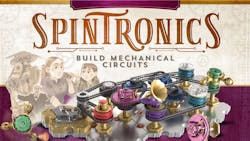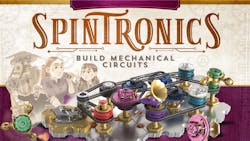Teaching Kids with Mechanical Transistors, Wind-Up Batteries—and Comics?
After five decades at the top of the Geek Toy food chain, the iconic Lego building toy may have a serious challenger when Spintronics launches on Kickstarter (May 20). The game's inventors, Alyssa and Paul Boswell, have created a highly engaging adventure game that rewards the player's ingenuity and creativity, is addictively fun to play, and just happens to teach kids (and interested adults) the fundamental principles of electronics in the process.
Mechanical Transistors and Wind-Up Batteries
Anybody with an EE degree would be rightfully skeptical of such a claim, since all but the most gifted of us had to struggle with the daunting math we needed to visualize, and model the behavior of the invisible flows of electrons, as we build circuits. Spintronics sidesteps the math in a novel way by creating mechanical equivalents of the most common electronic components (resistors, capacitors, inductors, transistors, etc.) that provide accurate visual representations of their functions. The snap-together system makes it easy to connect these components into “circuits” using drive belts that serve as “wires” and then power them with a wind-up mechanical “battery.”
The Spintronics system in action—a mechanical “circuit” powered by a wind-up “battery.”
The system is unlike traditional electronic educational toys, such as Snap Circuits (still one of my favorites), and the many other offspring of the original Gilbert "Erec-Tronic" circuit building kits. Spintronics allows players to literally “feel” the pull of voltage and “see” the flow of current through networks of passive and active components that they build themselves.
Co-creator Paul Boswell explains, “Instead of electrons flowing through wires, chains flow through circuit components like mechanical resistors, capacitors, inductors, transistors, and switches. Players build all sorts of crazy contraptions, and in the process, they discover important electronics concepts. Even many advanced concepts become obvious when you play with them in mechanical form.”
A “Fun-Up” Approach
By experiencing the behavior of invisible electrons in a tangible way, this game can make technology more interesting and understandable for both geeks and non-geeks. Unlike so many well-intentioned STEM toys that wrap their rather dry educational content in a thin veneer of fun activities, the Boswells have taken a “fun-up” approach to the kit's design. Although it can be used as a very innovative STEM education tool, complete with a series of lessons and exercises, Spintronics really shines when it's played as an engaging story-based game of discovery. Its engaging narrative is delivered by a beautifully illustrated online graphic novel.
In Spintonics’ game mode, you find yourself in the 19th century, a time before electricity powers the world, and you meet Natalia, a master clockmaker's daughter by day, and girl-genius inventor by night. When Natalia's parents are forced to leave the clockmaking business and move to a small, dreary rural town, Natalia recreates her parents' old workshop in their dusty shed and spends every evening tinkering until the lamp runs low.
The fun begins when she stumbles across an alternative technology that could revitalize the town—and maybe even change the world. Your mission is to help Natalia build increasingly sophisticated spintronics circuits to meet ever-more-challenging needs of the town.
The engaging narrative allows you to ride along with Natalia on her journey. She faces a series of increasingly complex challenges that require her to apply the mechanisms she's invented in new ways and uncover new ones that unlock even more possibilities.
A Novel Approach to Engineering Education?
Making it easier for non-engineers (and pre-engineers) to acquire a basic understanding of electronics and other STEM skills is a remarkable accomplishment. However, the Boswells also may have created an “on ramp” for non-traditional engineering students.
As my fellow EEs know, the way electronics is usually taught requires students to slog through a semester or two of absorbing highly abstract concepts before they get any sense of how they relate to the field they’re training to work in, or the applications they will be developing. Every class has its share of “natural engineers” for whom math is a native language. But many others like myself would do much better if we were able to start with getting a basic understanding of the principles we were working with starting in on the math we'd use to fully understand and apply them.
By providing a conceptual base to work from as they begin their training, teaching tools like Spintonics could enable many bright, creative young people who don't have the background or personality profile traditionally associated with engineers to embrace and excel at our profession. And from my experiences in our industry, that diversity would benefit both our workplaces and our bottom lines.
Buy or Try
The game goes live on Kickstarter on May 20 as a two-part adventure. The first part, known as “Act One,” explores the behavior of passive components in a series of 60 puzzles. Don't be put off by the term “passive,” since even humble switches, resistors, capacitors, and an “audible ammeter” can lead to big adventures in the Spintronics universe.
The Act Two kit adds 60 new adventures that introduce players to the properties of inductors and transistors(!), and many of the exciting applications they make possible. For the terminally geeky, such as myself, it might be worth buying the Act Two kit just to see how mechanical capacitors, inductors, and transistors work!
If you want to test-drive Spintonics before you buy, or don’t want to wait until this January for delivery of the actual kits, you can check out their rather realistic online simulator. The virtual Spintronics system allows you to construct, test, and run virtual versions of the same gadgets you'll encounter in the real-world game. Best of all, it's free!
Obligatory Reality Check
It should be noted that, as with any Kickstarter project, there’s a risk of delayed delivery or, in some cases, no delivery other than a refund if the campaign fails. That said, your odds are very good since the Boswells have a solid track record of delivering on previous campaigns. This includes their best-selling Turing Tumble game, which teaches you logic and programming as you design and build marble-powered computers.
About the Author
Lee Goldberg
Contributing Editor
Lee Goldberg is a self-identified “Recovering Engineer,” Maker/Hacker, Green-Tech Maven, Aviator, Gadfly, and Geek Dad. He spent the first 18 years of his career helping design microprocessors, embedded systems, renewable energy applications, and the occasional interplanetary spacecraft. After trading his ‘scope and soldering iron for a keyboard and a second career as a tech journalist, he’s spent the next two decades at several print and online engineering publications.
Lee’s current focus is power electronics, especially the technologies involved with energy efficiency, energy management, and renewable energy. This dovetails with his coverage of sustainable technologies and various environmental and social issues within the engineering community that he began in 1996. Lee also covers 3D printers, open-source hardware, and other Maker/Hacker technologies.
Lee holds a BSEE in Electrical Engineering from Thomas Edison College, and participated in a colloquium on technology, society, and the environment at Goddard College’s Institute for Social Ecology. His book, “Green Electronics/Green Bottom Line - A Commonsense Guide To Environmentally Responsible Engineering and Management,” was published by Newnes Press.
Lee, his wife Catherine, and his daughter Anwyn currently reside in the outskirts of Princeton N.J., where they masquerade as a typical suburban family.
Lee also writes the regular PowerBites series.






